| Politics of Nigeria |
|---|
 |
| Constitution |
| Government |
Legislature
|
| Judiciary |
| Subdivisions |
Elections
|
Foreign relations
|
|
|
This is a list of the heads of state of Nigeria, from independence in 1960 to the present day. The current constitution of Nigeria has the president of Nigeria as the head of state and government.
From 1960 to 1963, the head of state under the Constitution of 1960 was the queen of Nigeria, Elizabeth II, who was also the monarch of other Commonwealth realms. The monarch was represented in Nigeria by a governor-general. Nigeria became a republic within the Commonwealth under the Constitution of 1963 and the monarch and governor-general were replaced by a ceremonial president. Nnamdi Azikiwe served as the only indigenous governor-general of Nigeria.
Since Nigeria became a republic in 1963, 14 individuals have served as head of state of Nigeria under different titles. The incumbent president Bola Tinubu is the nation's 16th head of state. Olusegun Obasanjo and Muhammadu Buhari both served two non-consecutive periods as head of state, first as military officers and then later as civilians. The first ceremonial president, who served during the first republic was Nnamdi Azikiwe, while the first executive president of Nigeria was Shehu Shagari. Shagari was also the first president to be elected to the position.
The interim government of Ernest Shonekan who was deposed 83 days after taking office in 1993 is the shortest in Nigeria's history not including the tenure of Sir James Robertson who served 46 days as governor-general immediately after independence. Aguiyi-Ironsi served 194 days in the office, the shortest for a permanent head of state. Murtala Muhammed served 199 days in the position. Yakubu Gowon served the longest continuous period of almost nine years before being deposed while he was away from the country in 1975. Olusegun Obasanjo served the longest period for eleven years, two hundred and thirty days combined.
Five heads of state were deposed in a military coup (Nnamdi Azikiwe, Yakubu Gowon, Shehu Shagari, Muhammadu Buhari and Ernest Shonekan). Four heads of state died in office, two were assassinated during a military coup (Aguiyi-Ironsi and Murtala Muhammed), while two died of natural causes (Sani Abacha and Umaru Musa Yar'Adua). Three heads of state resigned, Olusegun Obasanjo and Abdulsalami Abubakar resigned after transition to democracy in 1979 and 1999 respectively, while Ibrahim Babangida was forced to resign after he annulled the 12 June 1993 presidential election in which SDP candidate MKO Abiola reportedly won. Olusegun Obasanjo was the first vice president (as Chief of Staff, Supreme Headquarters) to become head of state when Murtala Muhammed was killed during the 1976 Nigerian coup d'état attempt, while Goodluck Jonathan was the first democratic vice president to become head of state when Umaru Musa Yar'Adua died of Illness on 5 May 2010.
Monarchy (1960–1963)
Monarch
Main article: Monarchy of Nigeria (1960–1963)The succession to the throne was the same as the succession to the British throne.
| Queen | Reign | Royal house | Prime minister | Ref. | ||||
|---|---|---|---|---|---|---|---|---|
| No. | Portrait | Name (birth–death) |
Start | End | Duration | |||
| 1 | 
|
Elizabeth II (1926–2022) |
1 October 1960 | 1 October 1963 | 3 years | Windsor | Abubakar Tafawa Balewa | |
Governor-general
The Governor-general was the representative of the monarch in Nigeria and exercised most of the powers of the monarch. The governor-general was appointed for an indefinite term, serving at the pleasure of the monarch. Since Nigeria was granted independence by the Nigeria Independence Act 1960, rather than being first established as a semi-autonomous Dominion and later promoted to independence by the Statute of Westminster 1931, the governor-general was appointed solely on the advice of the Nigerian cabinet without the involvement of the British government, with the sole of exception of James Robertson, the former colonial governor, who served as governor-general temporarily until he was replaced by Nnamdi Azikiwe. In the event of a vacancy the chief justice would have served as officer administering the government.
| Governor-general | Term of office | Monarch | Prime minister | Ref. | ||||
|---|---|---|---|---|---|---|---|---|
| No. | Portrait | Name (birth–death) |
Took office | Left office | Time in office | |||
| 1 | Sir James Robertson (1899–1983) |
1 October 1960 | 16 November 1960 | 46 days | Elizabeth II | Sir Abubakar Tafawa Balewa (1912–1966) |
||
| 2 | 
|
Dr. Nnamdi Azikiwe (1904–1996) |
16 November 1960 | 1 October 1963 | 2 years, 319 days | |||
Republic (1963–present)
First Republic (1963–1966)
Main article: First Nigerian RepublicUnder the 1963 Constitution, the first constitution of the Federal Republic of Nigeria, Nigeria ran the parliamentary system of government with a prime minister and the president replacing the monarch as ceremonial head of state. The prime minister was formed by the leader of the party that won the election. The first federal election was won by the Northern People's Congress led by Abubakar Tafawa Balewa. The president was elected by Parliament for a five-year term. In the event of a vacancy the president of the Senate would have served as acting president.
| President | Term of office | Political party | Prime minister | Ref. | ||||
|---|---|---|---|---|---|---|---|---|
| No. | Portrait | Name (birth–death) |
Took office | Left office | Time in office | |||
| 1 | 
|
Dr. Nnamdi Azikiwe (1904–1996) |
1 October 1963 | 16 January 1966 | 2 years, 107 days | National Council of Nigeria and the Cameroons | Abubakar Tafawa Balewa (1912–1966) |
|
Military Government (1966–1979)
Main article: Military dictatorship in NigeriaMajor Chukwuma Kaduna Nzeogwu orchestrated the bloody military coup d'état of 1966 which overthrew the First Republic.
| Head of state | Term of office | Military | Ref. | ||||
|---|---|---|---|---|---|---|---|
| No. | Portrait | Name (birth–death) |
Took office | Left office | Time in office | ||
| 2 | 
|
Major General Johnson Aguiyi-Ironsi (1924–1966) |
16 January 1966 | 29 July 1966 (assassinated.) |
194 days | Central Military Government | |
| 3 | 
|
General Yakubu Gowon (born 1934) |
1 August 1966 | 29 July 1975 (deposed.) |
8 years, 362 days | Supreme Military Council | |
| 4 | 
|
General Murtala Mohammed (1938–1976) |
29 July 1975 | 13 February 1976 (assassinated.) |
199 days | ||
| 5 | 
|
General Olusegun Obasanjo (born 1937) |
13 February 1976 | 1 October 1979 (resigned.) |
3 years, 230 days | ||
Second Republic (1979–1983)
Main article: Second Nigerian RepublicUnder the 1979 Constitution, the second constitution of the Federal Republic of Nigeria, the President was both head of state and government. The president was elected for a four-year term. In the event of a vacancy the vice president would have served as acting president.
| President | Term of office | Political party | Cabinet | Elected | Ref. | ||||
|---|---|---|---|---|---|---|---|---|---|
| No. | Portrait | Name (birth–death) |
Took office | Left office | Time in office | ||||
| 6 | 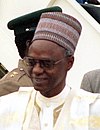
|
Alhaji Shehu Shagari (1925–2018) |
1 October 1979 | 31 December 1983 (deposed.) |
4 years, 91 days | National Party of Nigeria | Shagari | 1979 1983 |
|
Military Government (1983–1993)
Main article: Military dictatorship in NigeriaMajor General Muhammadu Buhari was made military head of state following the coup d'ètat of 1983, which overthrew the Second Republic.
| Head of state/ President |
Term of office | Military | Ref. | ||||
|---|---|---|---|---|---|---|---|
| No. | Portrait | Name (birth–death) |
Took office | Left office | Time in office | ||
| 7 | 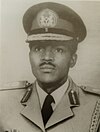
|
Major General Muhammadu Buhari (born 1942) |
31 December 1983 | 27 August 1985 (deposed.) |
1 year, 239 days | Supreme Military Council | |
| 8 | 
|
General Ibrahim Babangida (born 1941) |
27 August 1985 | 26 August 1993 (resigned.) |
7 years, 364 days | Armed Forces Ruling Council | |
Interim National Government (1993)
Main article: Interim National GovernmentChief Ernest Shonekan was made interim head of state of Nigeria following the crisis of the Third Republic.
| Interim Head of State | Term of office | Political party | Ref. | ||||
|---|---|---|---|---|---|---|---|
| No. | Portrait | Name (birth–death) |
Took office | Left office | Time in office | ||
| 9 | 
|
Chief Ernest Shonekan (1936–2022) |
26 August 1993 | 17 November 1993 (deposed.) |
83 days | Independent | |
Military Government (1993–1999)
Main article: Military dictatorship in NigeriaGeneral Sani Abacha led the palace coup d'ètat of 1993 which overthrew the Interim National Government.
| Head of state | Term of office | Military | Ref. | ||||
|---|---|---|---|---|---|---|---|
| No. | Portrait | Name (birth–death) |
Took office | Left office | Time in office | ||
| 10 | 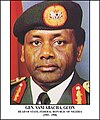
|
General Sani Abacha (1943–1998) |
17 November 1993 | 8 June 1998 (died in office.) |
4 years, 203 days | Provisional Ruling Council | |
| 11 | 
|
General Abdulsalami Abubakar (born 1942) |
9 June 1998 | 29 May 1999 (resigned.) |
354 days | ||
Fourth Republic (1999–present)
Main article: Fourth Nigerian RepublicUnder the fourth Constitution of the Republic of Nigeria, the president is head of both state and government. The president is elected by for a four-year term. In the event of a vacancy the vice president serves as acting president.
| President | Term of office | Political party | Cabinet | Elected | Ref. | ||||
|---|---|---|---|---|---|---|---|---|---|
| No. | Portrait | Name | Took office | Left office | Time in office | ||||
| 12 | 
|
Chief Olusegun Obasanjo (born 1937) |
29 May 1999 | 29 May 2007 | 8 years | People's Democratic Party | Obasanjo | 1999 2003 |
|
| 13 | 
|
Alhaji Umaru Musa Yar'Adua (1951–2010) |
29 May 2007 | 5 May 2010 (died in office) |
2 years, 341 days | People's Democratic Party | Yar'Adua | 2007 | |
| 14 | 
|
Dr. Goodluck Jonathan (born 1957) |
6 May 2010 | 29 May 2015 | 5 years, 23 days | People's Democratic Party | Jonathan I–II | 2011 | |
| 15 | 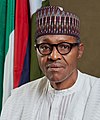
|
Muhammadu Buhari (born 1942) |
29 May 2015 | 29 May 2023 | 8 years | All Progressives Congress | Buhari I–II | 2015 2019 |
|
| 16 | 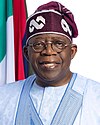
|
Bola Tinubu (born 1952) |
29 May 2023 | Incumbent | 1 year, 222 days | All Progressives Congress | Tinubu | 2023 | |
Timeline

Term of office in years
This is a list of each head of state in order of term length.
Of the 14 post monarchy heads of state, only two, Olusegun Obasanjo and Muhammadu Buhari, served in two non consecutive periods.
| Rank | Head of State | Political party | Longest continuous term | Total time in office | Periods | Cause of end of term |
|---|---|---|---|---|---|---|
| 1 | Olusegun Obasanjo | Military/Peoples Democratic Party | 8 years, 0 days | 11 years, 230 days | 2 | Resignation/Natural expiration |
| 2 | Muhammadu Buhari | Military/All Progressives Congress | 8 years, 0 days | 9 years, 239 days | 2 | Deposed/Natural expiration |
| 3 | Yakubu Gowon | Military | 8 years, 362 days | 8 years, 362 days | 1 | Deposed |
| 4 | Ibrahim Babangida | Military | 7 years, 364 days | 7 years, 364 days | 1 | Resignation |
| 5 | Goodluck Jonathan | Peoples Democratic Party | 5 years, 23 days | 5 years, 23 days | 1 | Natural expiration |
| 6 | Sani Abacha | Military | 4 years, 203 days | 4 years, 203 days | 1 | Death |
| 7 | Shehu Shagari | National Party of Nigeria | 4 years, 91 days | 4 years, 91 days | 1 | Deposed |
| 8 | Umaru Musa Yar'Adua | People's Democratic Party | 2 years, 341 days | 2 years, 341 days | 1 | Death |
| 9 | Nnamdi Azikiwe | National Council of Nigeria and the Cameroons | 2 years, 107 days | 2 years, 107 days | 1 | Deposed |
| 10 | Bola Tinubu | All Progressives Congress | 1 year, 222 days | 1 year, 222 days | 1 | In office |
| 11 | Abdulsalami Abubakar | Military | 354 days | 354 days | 1 | Resignation |
| 12 | Murtala Muhammed | Military | 199 days | 199 days | 1 | Assassinated |
| 13 | Johnson Aguiyi-Ironsi | Military | 194 days | 194 days | 1 | Assassinated |
| 14 | Ernest Shonekan | Independent | 83 days | 83 days | 1 | Deposed |
Standards
-
 Governor-general's standard (1960–1963)
Governor-general's standard (1960–1963)
-
 Presidential standard of Nigeria (1963–1966)
Presidential standard of Nigeria (1963–1966)
-
 Presidential standard of Nigeria (Armed Forces)
Presidential standard of Nigeria (Armed Forces)
-
 Presidential standard of Nigeria
Presidential standard of Nigeria
See also
Notes
- Goodluck Jonathan was Acting President from 9 February to 5 May 2010
References
- "Past Presidents & Heads of State". statehouse.gov.ng. Statehouse of Nigeria. Archived from the original on 14 August 2017. Retrieved 25 March 2022.
- "Shehu Shagari: President of the Second Republic". 25 February 2019.
- "Nigerian Military Leader Ousts Interim President". The New York Times. 18 November 1993.
- "Gowon Ousted in Nigeria; Coup ends Nine-Year Rule". The New York Times. 30 July 1975.
- "Olusegun Obasanjo: Nigeria's Three-Time President". 5 March 2019.
- "Nigerians Confirm Slaying of Ironsi". The New York Times. 15 January 1967.
- "Nigeria Confirms Killing of Leader". The New York Times. 15 February 1976.
- "Nigeria's president Yar'Adua dies".
- "June 12 presidential election was annulled to prevent coup - Babangida". 6 August 2021.
- "Nigeria Confirms Killing of Leader". The New York Times. 15 February 1976.
- "Nigeria's president Yar'Adua dies".
- "Yakubu Gowon | head of state of Nigeria". Encyclopedia Britannica. Retrieved 29 May 2020.
- ^ Kasuka, Bridgette (April 2013). Prominent African Leaders Since Independence. New Africa Press. ISBN 978-9987-16-026-6.
- Dimka's Confession: The Tragedy of a Nation. Bendel Newspapers Corporation. 1976.
- Purefoy, Christian (19 April 2011). "Widespread election violence erupts in Nigeria". CNN. Retrieved 20 April 2011.
- "BREAKING: Buhari declares June 12 Democracy Day to honour Abiola". Premium Times Nigeria. 6 June 2018. Retrieved 25 February 2019.
External links
| Heads of state of Nigeria | ||
|---|---|---|
| Queen (1960–1963) | ||
| President of the First Republic (1963–1966) | ||
| Military regime (1966–1979) | ||
| President of the Second Republic (1979–1983) | ||
| Military regime (1983–1999) | ||
| President of the Fourth Republic (from 1999) | ||
| *Civilian; headed transition to abortive Third Republic | ||
| Representatives of the monarch in Commonwealth realms and dominions | |||||||||||||
|---|---|---|---|---|---|---|---|---|---|---|---|---|---|
| National | |||||||||||||
| Sub-national |
| ||||||||||||
| Former | |||||||||||||